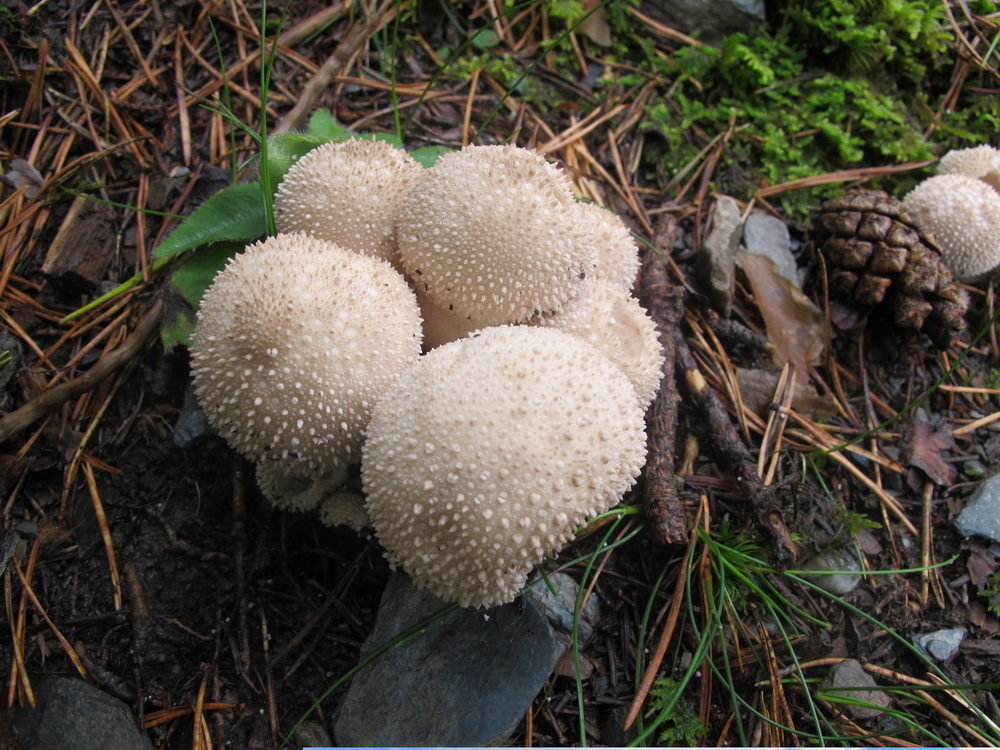
Common Name: Gem-studded Puffball, Common Puffball, Devil’s Snuffbox – The spiked protuberances that extend from the outer shell called the peridium are equated to embedded diamond-like studs, an oddly beneficent metaphor as fungi generally have more pejorative nomenclature (like devil’s snuffbox). The term puffball is descriptive of a round fungus that expels its spores in ‘puffs’ through a hole that develops in the peridium called an ostiole.
Scientific Name: Lycoperdon perlatum – The generic name is perhaps the most bawdy in all of taxonomy. Lycos is Greek for wolf and perdon is taken from the Greek perdesthai, which, from its derivative Sanskrit, means “to break wind.” Literally, then the notion is that the puffing of the spores is, with scatological metaphor, a ‘wolf’s fart.’ Peraltum is Latin for ‘common.’ It is sometimes also listed as L. gemmatum.
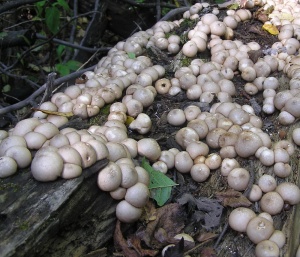
Potpourri: The Common or Gem-studded puffball and its close cousin the Pear-shaped puffball (L. pyriforme) are ubiquitous in their geographic and geologic habitat, prolific in their reproductive capacity and eye-catching in their globular whiteness against the dark hues of the forest. They are the two most frequently encountered species of 50 or so comprising the Lycoperdon genus of the order Lycoperdales, which includes 26 genera and 260 species. All puffballs are members of the series Gasteromycetes, a group of fungi that are distinct from the basidiomycete or mushroom fungi (those with caps, stems and gills with external self – ejecting spores) in that the spores are contained in a stomach – like case (gaster is Greek for stomach or belly) from which they must be expelled by an outside force. Along with puffballs, the Gasteromycetes are inclusive of stinkhorns, earthstars, bird’s nest fungi and false truffles. According to Bryce Kendrick in The Fifth Kingdom, Gasteromycetes are among the oldest fungal forms that “probably evolved so long ago that it is no longer possible to trace their ancestry (to basidiomycetes) with any degree of accuracy.”
The Lycoperdon common and pear puffballs are diminutive – typically about an inch in diameter, and gregarious – they occur in colonies. The only substantive habitat difference is that the pear puffballs are epigenous on wood, where they will frequently blanket an entire fallen log whereas common puffballs are terrestrial, gaining nutrients from plant roots with their extended hyphae. Common puffballs have spines for which the name gem-studded derives; the spines are deciduous, however, falling off with senescence to leave small pits that are not all that discernable. According to David Aurora in Mushrooms Demystified, they are among the most variable of all puffballs. Pear puffballs are (mirabile dictu) pear-shaped; the stem-like sterile base is tapered from the globular body in something like pear proportions – they look like little tan, upside-down pears. Both common and pear puffballs have a relatively thick outer skin called a peridium that protects the interior spore-producing mass called the gleba that starts out as a pliable, marshmallow-white interior and gradually turns yellow-brown as the spores mature. The gleba, which is with some irony the Latin word for ‘a clod of earth,’ is actually composed of sterile threadlike filaments called capillitium that bear the spores; slime molds have similar physiology. It is the pristine, spongy whiteness of the puffball gleba that is the key to its identification as a safe edible.
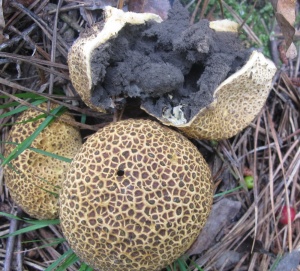
Puffballs are edible; in fact, so far as is known, all puffballs are edible. According to Charles McIlvaine (the doyen of mycophagists) in One Thousand American Fungi “No one has yet had reason to doubt the harmlessness of any puffball. There are a few that I have not eaten, but believing that these will be proven edible, descriptions of all species occurring in America are given.” As with all mushrooms, however, there are always cautionary notes. Lycoperdon puffballs have not one but two doppelgängers. The first is the alliterative Pigskin Poison Puffball (Scleroderma citrinum). It has a roughened, warty peridium (pigskin) and it looks like a puffball – round and growing on the ground in clusters. The deception is easily resolved by cutting it into two pieces to reveal a purplish-black spore mass in the center; consumption results in nausea and vomiting. The second “evil twin” is even more insidious; mistaken identity can result in renal failure mortality. Mushrooms of the genus Amanita have what is called a universal veil that surrounds the entire mushroom (cap and stem) in what looks initially like an egg (or a puffball) as it emerges from the ground. Amanita mushrooms contain amatoxins, among which are the most virulent of the mushroom poisons; the worst is the Destroying Angel (Amanita bisporigera). This mushroom earned its sobriquet legitimately, it is angelically white and devilishly deadly; it looks very much like a puffball when it first emerges. The deception can be readily righted by sectioning the fungus lengthwise; a consistent, cottony gleba indicates a puffball and an inchoate cap and stem indicates trouble. The bottom line: always section your puffballs (at least one in a cluster) to validate your preliminary identification.
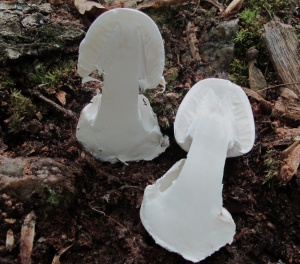
The fact that a fungus is edible does not necessarily mean that it is eatable. While puffballs have their detractors, the general consensus is that they are quite good. Gary Lincoff in The Audubon Guide to North American Mushrooms lists both the common and pear puffballs as ‘choice’ which is a step above edible. However, as with all things fungal, there are caveats. The smaller Lycoperdon puffballs are endowed with the same physiology as their larger cousins, the giant puffballs of the genus Calvatia (from calvus, Latin for ‘bald’). This results in a concentration of flavor that can be quite bitter when even a hint of yellowing is allowed. Again, according to McIlvaine “The flavor of puffballs appears to be issued to them as a ration. It is all there in the little fellow, and in a big one it is simply spread through for more substance.” If gathered then with caution and sensitivity to senescence, pear and common puffballs are quite tasty, best served after pan frying in olive oil. The fungal gourmand is also rewarded with surprising nutritional benefits; 100 grams of puffball contains 441 calories (actually kcal), 44.9 grams of protein, 42 grams of carbohydrates, and 5.5 milligrams of iron (42% RDA). A meatball should be so good.
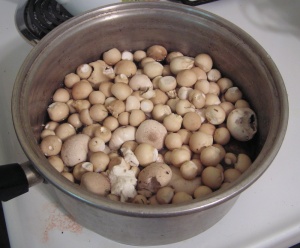
The eldritch puffs of what appears to be smoke emanating from unusual, small white orbs that contrast sharply and are alien to their immediate environs have intrigued the scientific, the curious and the aboriginal for eons. The mechanism is facile; as the spores mature and the gleba disintegrates, a small hole called an ostiole forms at the apical point to serve as an exit portal. The scientific question addresses the necessary motive force to expel the spores; ‘how does a puffball puff?’ A logical but incorrect hypothesis is that prevailing winds suck the spores out due to the venturi-effect of velocity lowering the pressure; you can demonstrate this by blowing across the top of the ostiole. However, prevailing natural winds rarely rise to the velocity of that produced orally. This so intrigued a scientist named Gregory in 1949 that he demonstrated in a small wind tunnel that this was the case. His second hypothesis was that a raindrop falling on a puffball would provide a sufficient impulse force; he accordingly demonstrated that pipetted water dropped on the peridium caused the spores to be ejected up to a height of several centimeters. His conclusion was that “Rain-drip from leaves during the fine rain consists of relatively large drops which made the puff-ball ‘smoke’ as though on fire.”
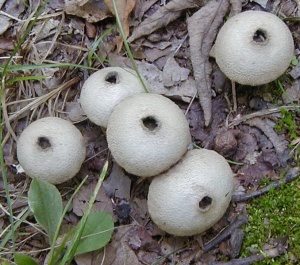
The curious are also intrigued by “wolf farts.” As a matter of historical record, on April 3, 1994, a group of adolescents in southeastern Wisconsin snorted puffball spores at a party, presumably to induce some sort of hallucinogenic effect (this is conjectural, but why else would they possibly have done this one might well ask). Three of the teenagers reported nausea within 12 hours and all eight participants developed a variety of symptoms including cough, fever, shortness of breath and fatigue within seven days. Five required hospitalization of whom two had to be intubated and subjected to lung biopsy, which revealed inflammation and fungal growths attributed to Lycoperdon spores, a condition known not surprisingly as lycoperdonosis. Nicholas Money in Mr. Bloomfield’s Orchard recommended the teens for the “Darwin Award” which was created to “commemorate those who improve our gene pool by removing themselves from it.” However, all of the patients recovered after a month with no apparent side effects and some have probably had children by now, who are likely mycophobic. Puffballs are a canine problem as well. In a 2009 article in the Canadian Veterinary Journal, a golden retriever was reportedly hospitalized after playing in a bed of puffballs to the extent that the cloud of spores masked the dog from view. The resultant clinical evaluation revealed fever and an elevated white blood count and a diagnosis of pneumonitis due to the inhalation of fungal spores.
The aboriginal peoples of North America variously incorporated puffballs into their cultures as spiritual, aesthetic, or medicinal according to separate tribal customs. The Blackfoot Indians called them ka-ka toos meaning ‘fallen stars’ and used them as incense to ward off evil spirits; a small circle of puffballs was painted at the base of the tepee to protect those within. The most prevalent use was as a styptic, to staunch the bleeding from a wound. The Rappahannock and Mohegan Tribes used the powder to stop bleeding, on occasion mixed with spider web to form a hemostatic dressing. The Dakota called them hokshi chekpa meaning ‘baby’s navel,’ using them to seal the umbilical. The use of puffballs to stop bleeding is likely universal; Robert James’ 1747 Pharmacopeia Universalis provided that “puff-balls, bull-cysts or molly-puffs .. When sprinkled in recent wounds it stops the hemorrhage, dries inveterate ulcers … but is thought prejudicial to the eyes.” This practice extended to the English colonists, the rural denizens of Pennsylvania kept a string of puffballs near the fireplace for emergencies.
